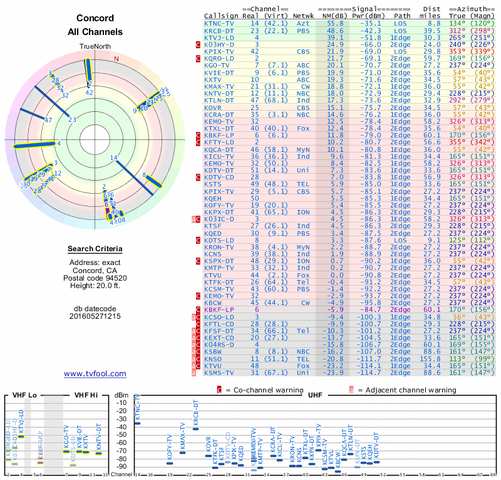Let us know what you decide, and how it all works out for you.
Larry
Hi Larry,
It's been a while since we chatted on this. I've moved and finally got the OTA antenna up. The TV situation here is enough to put up with but it's not perfect.
I'm running a Channel Master CM5018 and a Channel Master Titan 2 masthead amplifier. The antenna is about six feet above the roof top of a single-story house. It's on a rotator. I tried it with and without the amp and the amplifier did bring signals up a bit.
My biggest problem is that I can't get reliable reception on San Francisco channels. Some, including KTVU, are missing altogether and others, including KPIX, KQED and KGO are spotty at best. I get KNTV OK, but I believe that's because it's repeated on a local Telemundo station. I'm getting better signals from Sacramento, although I also can't pull in Fox from there.
My experience is also quite different from the TV Fool report (attached), which makes me wonder if I'm dealing with some localized interference, reflections from a building or something else.
Looking at it, KPIX should be the strongest of all the SF stations, but I only managed to get the TV (Sony XBR-X850D) to scan it in yesterday after weeks of trying. To get it, I'm pointing away from SF, which furthers my suspicions after multipath or reflections.
KGO comes in OK usually, but the antenna doesn't have much margin for aiming error. KVIE and KXTV are much easier to receive. The San Jose stations come in very well.
The biggest problem with sourcing TV from Sacramento is the loss of local news, otherwise I'm happy with watching other shows on those stations.
Any ideas for things to try?
I do have another possible clue. Quite early on when I was running the antenna cable across the living room floor and had the amplifier power plug in a different socket, switching on one set of the living room lights caused me to lose all reception. It literally was coming and going with the light switch. The other set of lights had no effect and they are the same fittings and LED bulbs. Now the antenna cable is coming under the house, I'm not seeing this anymore.
Thanks for any help you can provide.



